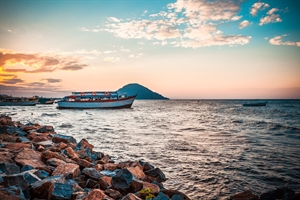Schistosomiasis (bilharzia) occurs when microscopic parasites enter the skin and migrate to the veins around the bladder and bowels where they lay eggs. Infestation can last up to eight years and can cause long-term damage to the bladder, kidneys, bowel, liver and genital tract.
How can I avoid schistosomiasis?
Check before you travel whether you are visiting a place where schistosomiasis occurs. When you come for your appointment at Global Travel Clinics for your travel vaccinations, you can ask for more information about the risk of contracting schistosomiasis at your destination.
To avoid schistosomiasis completely, you should not swim or shower in fresh, untreated water (such as rivers and lakes) in regions where schistosomiasis is endemic. Poor sanitation increases the risk of schistosomiasis transmission. Watch out for campsite showers that draw water directly from a lake. You should also avoid water sports such as rafting and paddle boarding in a region where schistosomiasis occurs.
To learn more, see NHS Fit for Travel’s advice on schistosomiasis.
Where might I catch schistosomiasis?
There are two types of schistosomiasis. Intestinal schistosomiasis occurs in:
- Africa
- the Middle East
- the Caribbean
- Brazil, Venezuela and Suriname
- China, Indonesia, the Philippines, parts of Cambodia and the Lao People’s Democratic Republic
Urogenital schistosomiasis occurs in Africa, the Middle East and Corsica.
What are the symptoms of schistosomiasis
The World Health Organization says that an infestation of schistosomiasis worms is not life-threatening for most healthy people – it is more of a problem for people who live in countries where schistosomiasis is endemic because they may get repeated infections.
Urogenital schistosomiasis manifests as blood in the urine. Intestinal schistosomiasis will result in diarrhoea, belly ache, blood in the stools and tiredness. Women may experience gynaecological symptoms such as spotting, cramps, pain and bleeding.
If you have been in to a country where schistosomiasis occurs, and you have these symptoms, go and see your GP and let them know about your travel history.
I think I have schistosomiasis
You will have to wait until eight weeks after exposure to get tested. Visit your GP, describe your travel history and ask for a schistosomiasis assessment. Your doctor may send a stool, urine or blood sample for testing.
Schistosomiasis is treated with a drug called praziquantel. It is best to avoid treatments bought over the counter abroad: they may be counterfeit, and if the dose is not taken at the right time, it will not be effective.
How is schistosomiasis transmitted?
An infected person excretes the eggs in their urine or faeces and in places with poor sanitation, the eggs enter freshwater sources. The eggs hatch and the larvae find a particular variety of snail which acts as a host for a time. They then leave the snail and enter the water as a free-swimming tailed larva, which enters a human host through the skin. Once the larva has entered the skin, it migrates to the blood vessels around the bladder or intestines. The larva matures, mates and lays eggs which enter the bladder or the intestines and are excreted.


Book Online